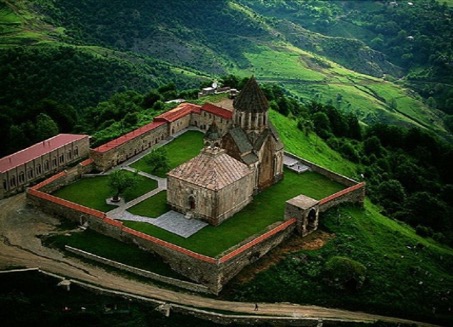These influences have helped shape its centuries-old history and forge its pluralistic national identity. located on the ancient Silk Road, the simple deposits of ancient currencies reveal the complexity of the trade that the Caucasus has witnessed since ancient times. The sixty or so languages spoken in these mountains, corresponding to as many ethnic groups, allow you to get a first idea of this fascinating linguistic museum. Although it is now recognized that Azerbaijan is home to communities with diverse cultures and beliefs, it is little known that it was the historic cradle of the Caucasian Albanian Church. An Orthodox, apostolic and autocephalous Church, born in the heart of a great kingdom now considered extinct, known as the Albania of the Caucasus. The known written sources and material culture attest, from the 1st century onwards, the existence of a large mosaic made up of 26 tribes, marked by a dominant ethnic group : Albanians. Tribes that include the Guéles, the Legues, the Oudis, the Gargareans, the Tchilbes, the Silves, the Lupenes, the Tsodians and the Caspes.

A BLACKED OUT CHURCH AND CIVILIZATION
Blacked out from end to end, the name of the Caucasian Albanian Church, not to be confused with the Balkan Albanian Church, will remain so until this day of seven. 1937. A famous Georgian linguist named Ilia Abuladze, discovered then, while studying an Armenian manuscript completed of writing in 1442 (Matenadaran MS 7117), a series of unusual alphabets. This discovery made a great deal of noise within the small circle of experts, but it remained insufficient to be able to identify, without ambiguity, the origin of this hitherto unknown alphabet.
In 1947, new inscriptions were discovered during the construction of the large dam in the town of Mingatchevir, Azerbaijan. Identical to the manuscripts transcribed in the Armenian manuscript, they were carefully engraved on some funeral steles. A dozen lines in all, but which had the advantage of confirming that the series of foreign alphabets discovered in the Armenian manuscript was evidence of historical value. A few years later, a new corpus containing an alphabet identical to the previous ones was discovered in 1952. However, due to the short inscriptions and the poor physical condition of the whole, the content proved disappointing.
Later, in the Orthodox monastery of St. Catherine of Mount Sinai (Egypt), following a fire that devastated several premises in May 1975, a space sheltered under the collapsed floor was discovered. Of the 1100 mss it contained, 140 of Georgian origin had been housed there since the 18th century. Of them, two proved decisive: N Sina 13 and 55, two codices written on parchment. Dating back to the 10th century, the two manuscripts announced themselves to be entirely palimpsestes (a support from which the original text was erased in order to replace it with a new one) each containing an Albanian text in unicals arranged on two columns without spaces between the words. After comparing the writing of the two palimpsestes, with the alphabet of Matenadaran MS 7117 and the lapidary inscriptions found in Azerbaijan in 1947 and 1952, the philologists’ observation was indisputable. The two Georgian manuscripts, N Sina 13 and 55, were made from a single Albanian-language manuscript now missing.
A KINGDOM WITHDRAWN FROM OBLIVION
The patient and thorough study of the manuscripts continued until 2000, and the conclusion of the philologists and mythologists of the Caucasus was unambiguous. By delivering the religious vocabulary of the third Christian state of Transcaucasia, the Albanian lectionary of Sinai provides new insights into the conditions of his Christianization which, according to medieval Armenian historiography, is attested that many Albanian churches were erected in the Holy Land. Other written sources testify to the brotherhood between Georgians and Albanians during the 10th century. and which manifested itself without distinction in Jerusalem and on the Sinai. A testimony expressed, centuries later, through the manuscripts of the monastery of Mount Sinai ; rare survivors of the abundant Albanian literature who reveal the close relationship between the Albanian Church in the Caucasus and its sisters in the Middle East.
On the basis of these various discoveries, one realizes that medieval written sources which claimed that the first churches of Caucasian Albania date back to the 1st century. So they were right. In this regard, the written testimony of Moses of Kalankatuk (7th century) is invaluable. “In Jerusalem, Elisha was ordained by Saint James, brother of Jesus, who was the first patriarch of Jerusalem. Elisha received the East as a gift… He arrived in Guis (northern Azerbaijan), founded a church and offered a sacrifice. This place is the primary source of our churches, the source of the old capitals and the beginning of a place of radiance.” However, it was not until the middle of the 4th century that Albanian kings officially adopted Christianity and began to mint local currency in Gabala, the first capital of Caucasian Albania.
These various elements, which confirm the formal existence of the Albanian Church in the Caucasus, do not fail to pose a delicate question : What are the reasons that led to the extinction of this once flourishing Church, right down to its alphabet ?
And it’s a little confusing, given that there are testimonies about the Albanian language and its writing in Strabo, Hippolytus the Roman, Moses of Kalankatuk, Korioun, Sebeos, Moses of Khorene, Zechariah the Rhetor, Hethum, in addition to several Arab chroniclers. Thanks to them, it is known that Albanian writing was formed on the basis of Gargarean speaking, rich in guttural and composed of 52 phonemes, many of which are whistling and whispering. As in the case of Armenia and Georgia, the emergence of the Albanian language and literature in this language is linked to the Christianization of the country. Faced with the policy of assimilation pursued by the Sassanids, their desire to impose Mazdeism and the action of the Syrian church, it was absolutely necessary to oppose in the country a local-language Christian church and a literature that could preserve the cultural and cultural independence of the Albanians. The Bible and other religious texts were translated at the same time as a tradition of historical literature was instituted. The chronicles include the history of the Albanians of Moses of Kalankatuk, the Albanian Chronicle and the Code of Mekhitar Goch, as well as the history of Kirakos Gandzaketzi. The question remains, after all.
CAUCASUS ALBANIA : A PLACE OF PRIMITIVE CHRISTIANITY

According to Klaudia Trever, a specialist in the history of this region, Albania in the Caucasus was home in its remote times, in addition to the Christianity adopted by the court and the nobility, to the Zoroastrianism introduced by the Sassanids, as well as various historical pagan sects[4]. A period marked by numerous ideological struggles. On the one hand, against the Zoroastrianism of the Sassanid Empire. On the other hand, against the assimilation policy of the Armenian Church, which persisted in subjecting the Albanian Church. The arrival of Islam in the region, in the second half of the 7th century, will allow the Albanian Church, inadvertently, by ending the Sassanid hegemony and by curbing Armenian and Georgian intentions, to resume its development. The arrival of the Abbasid caliphs in power allowed their governor of the Caucasian province in 789 to transfer his residence to Barda, in the heart of present-day Azerbaijan. This new closeness gave the Albanian Church a definite advantage. A political development that prompted the Armenian historian, Łewond, around 779, to recognize in the expansion of Islam an irreversible worldwide process: strict respect for freedom of worship.

The treatment of the different local religions on the same basis of equality enabled the Albanian Church to persevere and prosper. Twelfth century. the latter is experiencing a real boom in cultural architecture. During this period, new churches were built, the oldest were restored and new architectural models were created. For example, Khatiravang Monastery, erected in 1204 and located in the Kelbadjar district of Azerbaijan, can be mentioned. The Khudavang monastery, registered with UNESCO as a monument of world importance. A high place, located in the district of Kalbajar (Azerbaijan) and which developed over several centuries on the bases of the Arzu Khatun cathedral, named after the wife of Prince Vakhtang of the Upper Cross, built in 1214.
And finally, the monastery of Gandzasar located in the district of Terter (Azerbaijan). Founded in 1216, one of its epigraphs reads “built on the insistence of the Albanian patriarch for the Albanians”. A monastery that was the spiritual center of the independent Albanian principality, the residence of the last Albanians of Catholic obedience until 1836, when it was abolished.
A TRAGIC END
In the 19th century, while practicing a policy of Russification, the Tsar Empire did not fail, unfortunately, in times of crisis, to stir up inter-ethnic tensions, encouraging some to massacre others, under the pretext of restoring order. In this vein, in 1836, the Tsarist government decided to abolish the autocephalous Church of Albania and subordinate it to the Armenian Gregorian Church. A little later, at the beginning of the twentieth century, the Armenian Gregorian Church, with the permission of the Russian Holy Synod, endeavored to destroy the records of the Caucasian Albanian Church, as well as those of the library of the Patriarchs of Albania in Gandjasar which contained the most valuable historical documents, as well as the originals of Albanian literature. The Albanian Church, having often expressed a desire for autonomy and even autocephaly towards the Armenian and Georgian Churches, paid a high price.

The later settlement by Tsarist Russia of Armenians from the Ottoman and Persian Empires in the territories of the khanates of Karabakh, Erivan and Nakhchivan accelerated this process. As soon as the Armenian Church was established in these newly conquered territories, it quickly set up a vast process of armenization of the cultural and cultural heritage of this former Caucasian Albania.However, attempting to bury the truth as much as possible will not prevent anyone from eventually exhuming it. During an archeological expedition to Karabagh begun between 1918 and 1919, the president (1943-1947) of the Academy of Sciences of Soviet Armenia, Joseph Orbeli, studied and described more than 1000 epigraphs etched on the wall slabs of the churches and monasteries of Karabagh, in particular that of Gandjasar. On the basis of the results of his research published in his book ‘Inscriptions of Gandjasar and Havotsptuk’, the Armenian archeologist concludes that this ancestral cultural architectural heritage is that of the Caucasian Albanian Church. In essence, this is not surprising, given that other similar cases exist. The Urartian sites of the Republic of Armenia, which date back to the 1st millennium BC, are the pride of all Armenians, even though they have no direct link with the origins of their nation[2].
The Caucasian Albanian Church is an intrinsic part of the world heritage in general and Christian in particular. Let’s protect him, starting with making him better known.
Karim IFRAK, Islamologist and codicologist specializing in the geopolitics of the Muslim worlds.











